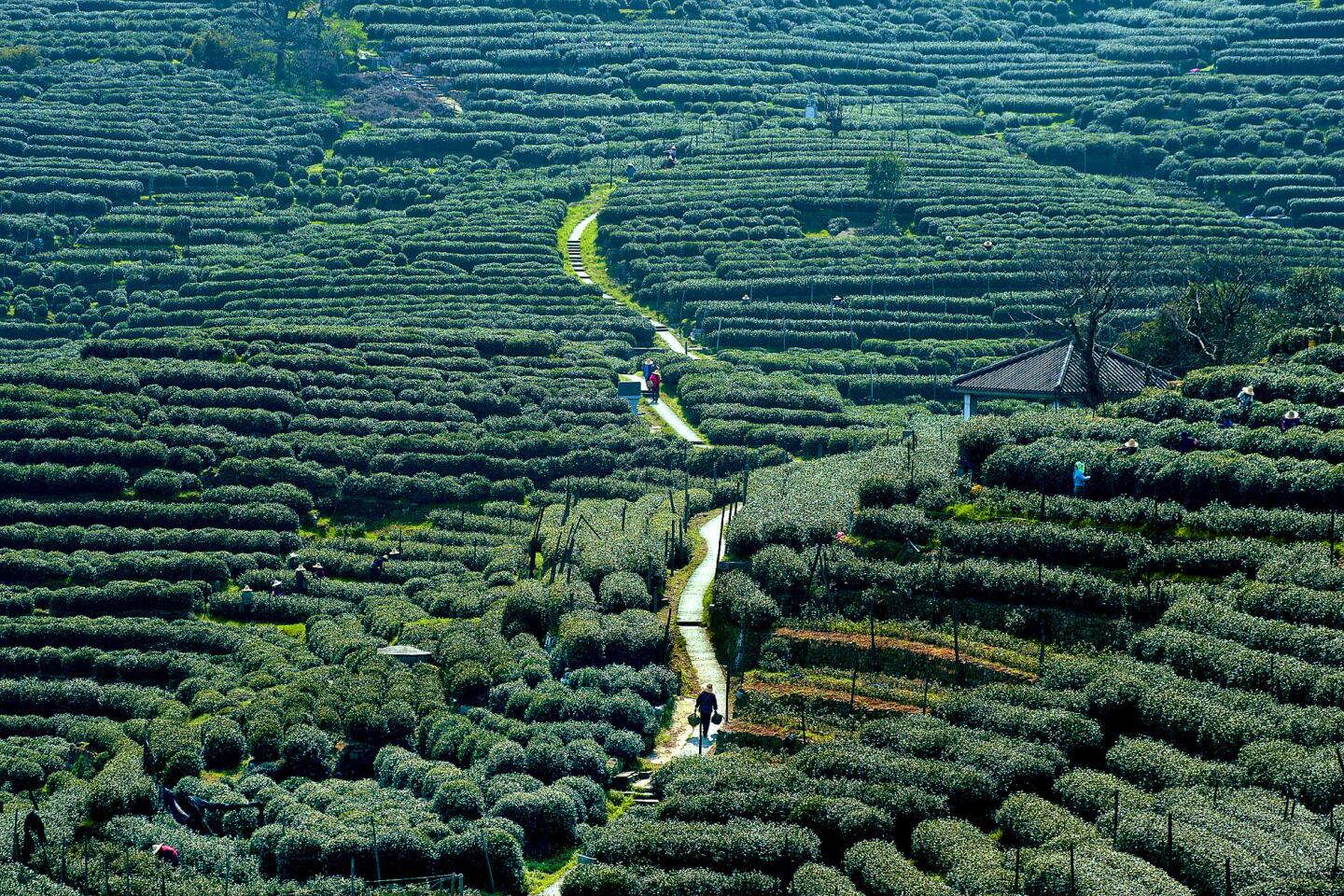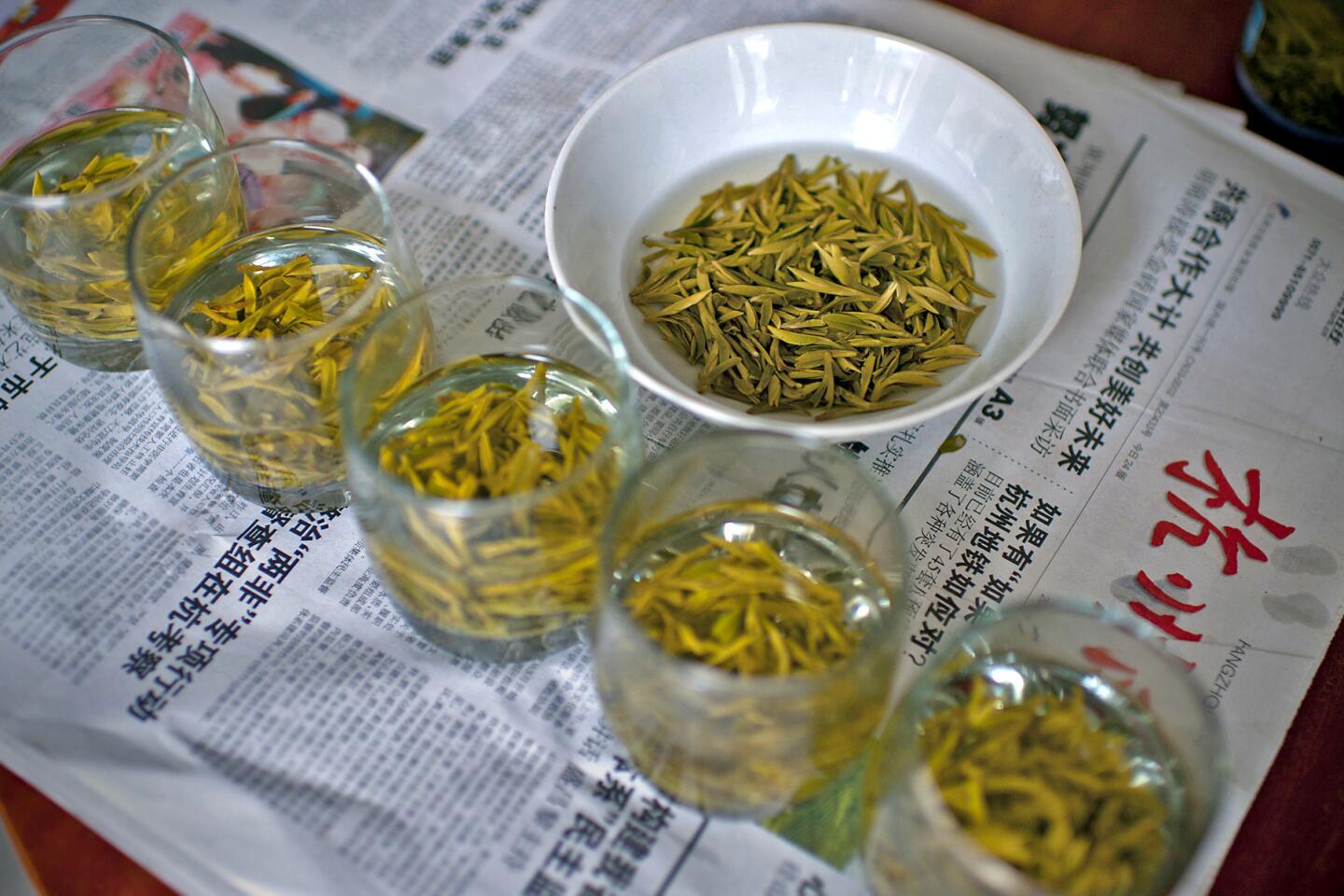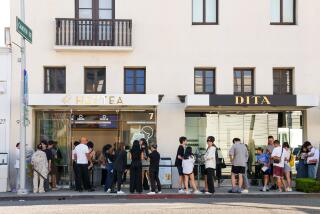China: Sips of Hangzhou are savored like a fine tea
- Share via
HANGZHOU, China — Few cities in this vast, complex land rival Hangzhou in the hearts and minds of the Chinese.
They rush in like pilgrims, more than 20 million a year, eager to drink in the classic scenery of mountains, pagodas and tea fields while reveling in the cultural grandeur of the vanished Southern Song dynasty.
The Song, who believed Confucian values were best elevated through the arts, made Hangzhou their capital, appointing poets as governors who drew inspiration from the shimmering West Lake in the center of town.
When Marco Polo visited in the 13th century, he described a 100-mile-wide metropolis of canals crossed by 12,000 bridges, sumptuous pears weighing 10 pounds each and perfumed courtesans skilled in the “arts of allurement.”
“A city of heaven,” the Venetian traveler declared, “the finest and most splendid city in the world.”
Everyone I met in Shanghai, an hour away by train, urged me to go. The lake, the temples, the history, they said, would help me understand China. All true, but I had something less lofty in mind — the prospect of an exceptionally good cup of tea.
After a nasty battle with cancer, I became an avid tea drinker, convinced that every swig of the antioxidant-rich brew fortified me against a recurrence. I routinely drink half a gallon a day. Green teas are my favorite, and Hangzhou is home to one of the best on Earth.
Shortly after arriving, I picked up a brochure from the Hangzhou Tourist Commission.
“In this earthly paradise, you’d better do nothing but take a walk in the scenic village path, breathe fresh tea aroma in green woods and listen to moving love stories beside the West Lake,” it said. “Close your eyes and enjoy Hangzhou with all of your heart.”
I was skeptical. Hangzhou looked less a paradise than a teeming city of 8 million. Cars, pedestrians and motorbikes played chicken on streets and sidewalks. Noisy construction sites rattled and banged.
“Listen, Hangzhou is the best city in China, at least according to Marco Polo,” said Stone Shih, a local college teacher and occasional tour guide hanging out in the lobby of my hotel. “The tea is so good here you can actually eat it. You can eat a cup of tea!”
Eat a cup of tea?
Hangzhou’s subtropical, drizzly climate produces longjing, or Dragon Well tea, an expensive variety famed throughout the world.
I headed for the National Tea Museum to learn more.
The museum, surrounded by manicured tea fields, offered a detailed journey through the history of tea.
The first recorded tea drinkers were the Ba-Shu of China’s Sichuan province. The habit became a symbol of upper-class refinement during the Tang dynasty and a mass-market commodity under the Southern Song who ruled from 1127 to 1279.
Cakes of tea the size of wagon wheels were given as tribute to emperors, and longjing was allegedly offered to Buddha himself.
I bought 2 ounces of the stuff for $25 in the museum shop. The taciturn clerk carefully weighed out the tea leaves like bits of gold, depositing them into a small, green tin.
Once outside, I asked a cabbie to take me into the green hills surrounding the city. A half-hour later, he dropped me in Weng Jia Shan, a tea-growing village engulfed in rain and fog, where I was immediately waylaid by hawkers.
“Drink tea? Drink tea?” they cried from open doorways.
Old men leapt up from mah-jongg tables making sipping motions. Women trailed me with jars of tea leaves. A young woman batted her eyes before a nicely set table, “Just taste,” she purred. The prices were extortionate, often three or four times higher than the museum’s.
Earlier that day a guide had offered to show me around.
“Don’t buy the tea at the museum,” he warned. “Buy it in the villages.”
“Why?” I asked.
“Because then I’ll get a commission,” he replied.
I suddenly wanted a cup of coffee.
Plus I was lost, and my Chinese was severely limited. A narrow path led down the mountain, so I took it.
In a moment the world changed, swallowing me up in a profusion of green.
Arched stone bridges crossed ponds laden with lotus plants. Nameless paths forked left and right. I entered a misty bamboo forest planted by a Buddhist monk 1,000 years ago.
Down, down, past Bamboos in the Wind Ridge, through the serene Guioxi Pavilion with its walls of inscribed poetry.
The land opened up, terraced tea fields spreading into the mountains on either side.
This was Dragon Well, where tea has been cultivated since the 9th century. Emperor Qianlong of the Qing dynasty fell so madly in love with these jade hills that he made a list of his favorite spots — the Top Eight Scenes of Dragon Well.
I realized I was walking through every Chinese watercolor painting I’d ever seen. Mountains, emerald pools, upturned roofs crowned with dragon heads — scenes that have inspired a thousand romantic journeys.
“Places like Hangzhou are places of cultural memory where you go to connect with the past,” said Richard von Glahn, a frequent visitor to the city and a professor of Chinese history at UCLA. “The original city is long gone, but the setting — West Lake and the mountains — is still here. Hangzhou continues to inspire.”
The path ended near Lingyin Temple, founded in 326 and a major center of Zen Buddhism.
Before reaching its gates I crossed a stream and walked up Feilai Feng, or Peak That Flew From Afar, with its hundreds of Buddhas, including a fat laughing one, carved into the mountainside and dating back more than a millennium.
Lingyin’s main attraction is an 80-foot-tall Buddha made of camphor wood and gold. Pilgrims outside bowed and burned incense. It was November, and autumn winds sent the fragrant smoke billowing over the temples and into the heavens. The air was crisp, the mood transcendent.
After hours of blissfully wandering the temple grounds, I caught a taxi to the Hupanju Tea House overlooking West Lake. Once inside the waitresses eagerly pounced on my every request.
I had but one — longjing tea.
They brought me a glass garnished with a kumquat and sweet osmanthus flowers. It was the best green tea I’d ever tasted — mild, sweet and nutty. I drank endless glasses while happily grazing on dragon fruit, dried fish and abalone.
Outside, the setting sun cloaked the slow-moving boats in golden light. Causeways led to islands that once served as refuges for poets such as the famous Su Dongpo.
“It’s gorgeous under clearing skies, a lake all billows and light, and lovely too in rain, mountain colors among empty mists,” he wrote. “I can’t help comparing West Lake to Lady West, her makeup just barely there or laid on thick: she’s exquisite either way.”
Swollen with tea, I slowly circled the three-square-mile lake, enjoying place names such as Melting Snow at Broken Bridge and Three Pools Reflecting the Moon.
Rarely have I seen so many people enjoying a place so completely. Peddlers sold candied apples and octopus on a stick. Street musicians played lutes and zithers as elderly couples waltzed in time. Jewel-like koi flashed in the shallows.
That evening I attended a performance of “The Romance of the Song Dynasty” just outside the city.
I ran into Stone Shih escorting a tour group going in. He was, as always, brimming with information.
“When Nixon came to China in 1972, he watched this play and loved it,” he said. “This is the ‘Romeo and Juliet’ of the Song dynasty, and it helped thaw relations between the U.S. and China.”
I squeezed into the dark theater with thousands of others.
Then my mind was blown.
For the next hour I witnessed the most colorful, psychedelic spectacle I’ve ever seen. It snowed on stage, it rained on stage, horses galloped on stage. Performers dressed as butterflies, tea leaves and courtesans.
Beautiful women in lotus flower costumes sang while twirling lily pad parasols.
I loved it and can’t even tell you what it was about.
Hangzhou had worked its magic.
I had arrived a skeptic but left with a Song in my heart.
Now for a cup of tea.
More to Read
Sign up for The Wild
We’ll help you find the best places to hike, bike and run, as well as the perfect silent spots for meditation and yoga.
You may occasionally receive promotional content from the Los Angeles Times.








